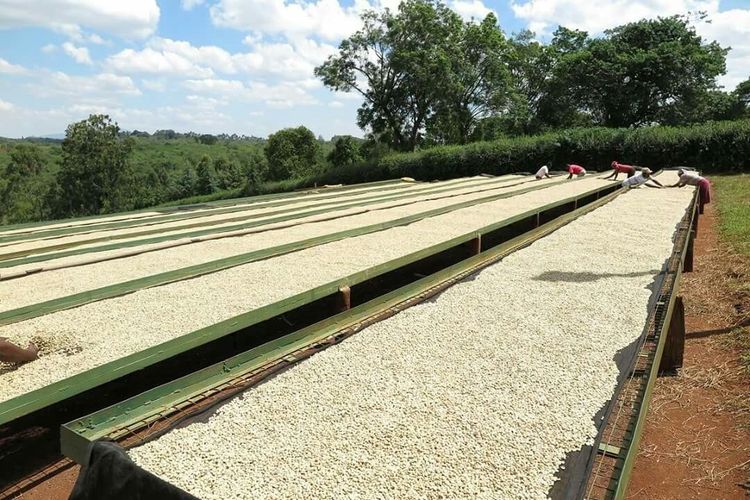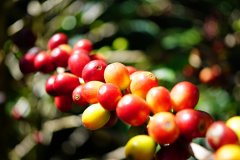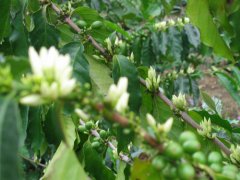Coffee that changed Costa Rica's destiny One of the best boutique coffees in the world Introduction to a big country
For professional baristas, please follow the coffee workshop (Wechat official account cafe_style)

Coffee has been rooted in Costa Rica for more than 200 years.
Although the land area is only the third to last among the producing countries in Central America.
But it is an indispensable and important role; at present, the total population of Colombia is about 4.5 million.
While there are as many as 400 million coffee trees.
Coffee exports account for 25% of the country's total exports.
According to local statistics, about 1% of the population is involved in the coffee-related industry chain.
It is not too much to say that coffee has changed the standard of living in this country.
Costa Rica has a unique natural environment, fertile volcanic ash,
Mild and suitable temperature and stable and abundant rainfall
Sufficient sunshine time during the day and significant temperature difference between day and night
It is one of the reasons why coffee has become one of the main agricultural products in Colombia.
They also produce different grades of coffee and raw beans.
From commercial parity Arabica beans
To the coffee raw beans from the Outstanding Cup Coffee Competition (COE)
There is also a palace-level geisha coffee variety (Geisha).
In addition, various post-processing methods are not clear, yellow, red and black.
The dazzling list is too numerous to mention. The traditional classification method classifies Costa Rica into seven producing areas.
From northwest to southeast
With the distribution of the inland central plateau, the western valley (West Valley),
Central Valley (Central Valley),
Tarasu (Tarrazu), Sanshui River (Tres Rios), Eurosci Orosi,
Brenka (Brunca), Duli Alba (Turrialba)
Some of them may be familiar to everyone in Taiwan's coffee market.
But with the evolution of boutique coffee
The norms of large producing areas can no longer satisfy the curiosity of lovers chasing high-quality coffee.
Resulting in more and more microzones.
Trace batches of small estates were unearthed.
Important Notice :
前街咖啡 FrontStreet Coffee has moved to new addredd:
FrontStreet Coffee Address: 315,Donghua East Road,GuangZhou
Tel:020 38364473
- Prev

Introduction to the black honey treatment of the peak manor in the western valley region. Coffee tastes like honey.
Professional barista exchanges please follow the coffee workshop (Wechat cafe_style) Costa Rica West Valley Don Joel Black Honey La Cumbre Farm Costa Rican Coffee Western Valley Tanghouye processing plant peak manor black honey treatment flavor description: dry aroma is BlackBerry, citrus and caramel, citrus, grapefruit, BlackBerry, black when sipping
- Next

Guatemala coffee best Santa Felicia estate introduction and red label batch of coffee beans
Weixin Official Accounts cafe_style Country: Guatemala Production area: Acatenango Variety: Huangkadu Ai Elevation: About 1,542 m (Manor's own processing plant elevation) Coffee tree planting altitude: About 1,550- 1,920 m Annual rainfall: 1200mm 1500mm Treatment method: Orange honey treatment method G
Related
- Does Rose Summer choose Blue, Green or Red? Detailed explanation of Rose Summer Coffee plots and Classification in Panamanian Jade Manor
- What is the difference between the origin, producing area, processing plant, cooperative and manor of coffee beans?
- How fine does the espresso powder fit? how to grind the espresso?
- Sca coffee roasting degree color card coffee roasting degree 8 roasting color values what do you mean?
- The practice of lattes: how to make lattes at home
- Introduction to Indonesian Fine Coffee beans-- Java Coffee producing area of Indonesian Arabica Coffee
- How much will the flavor of light and medium roasted rose summer be expressed? What baking level is rose summer suitable for?
- Introduction to the characteristics of washing, sun-drying or wet-planing coffee commonly used in Mantenin, Indonesia
- Price characteristics of Arabica Coffee Bean Starbucks introduction to Manning Coffee Bean Taste producing area Variety Manor
- What is the authentic Yega flavor? What are the flavor characteristics of the really excellent Yejasuffi coffee beans?

